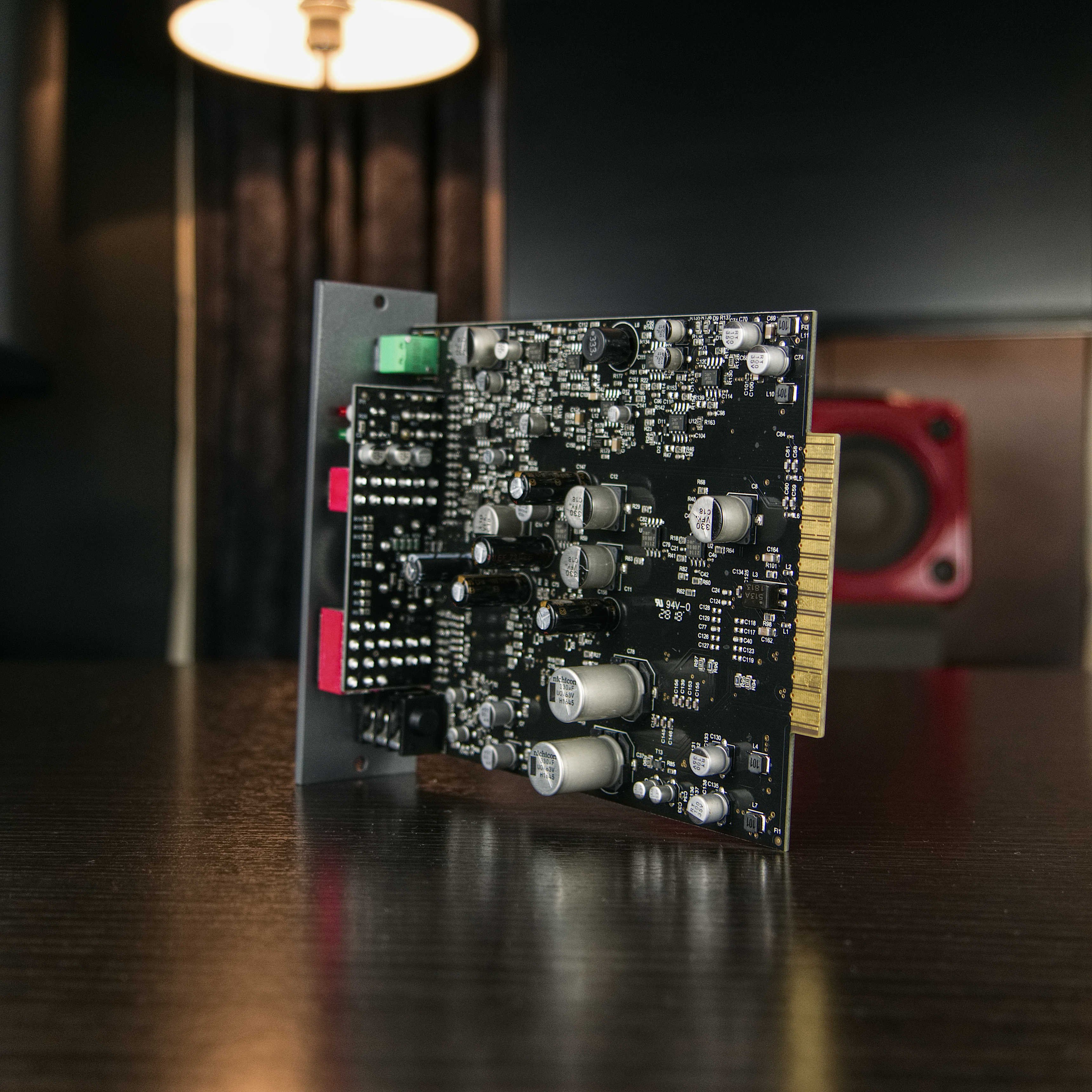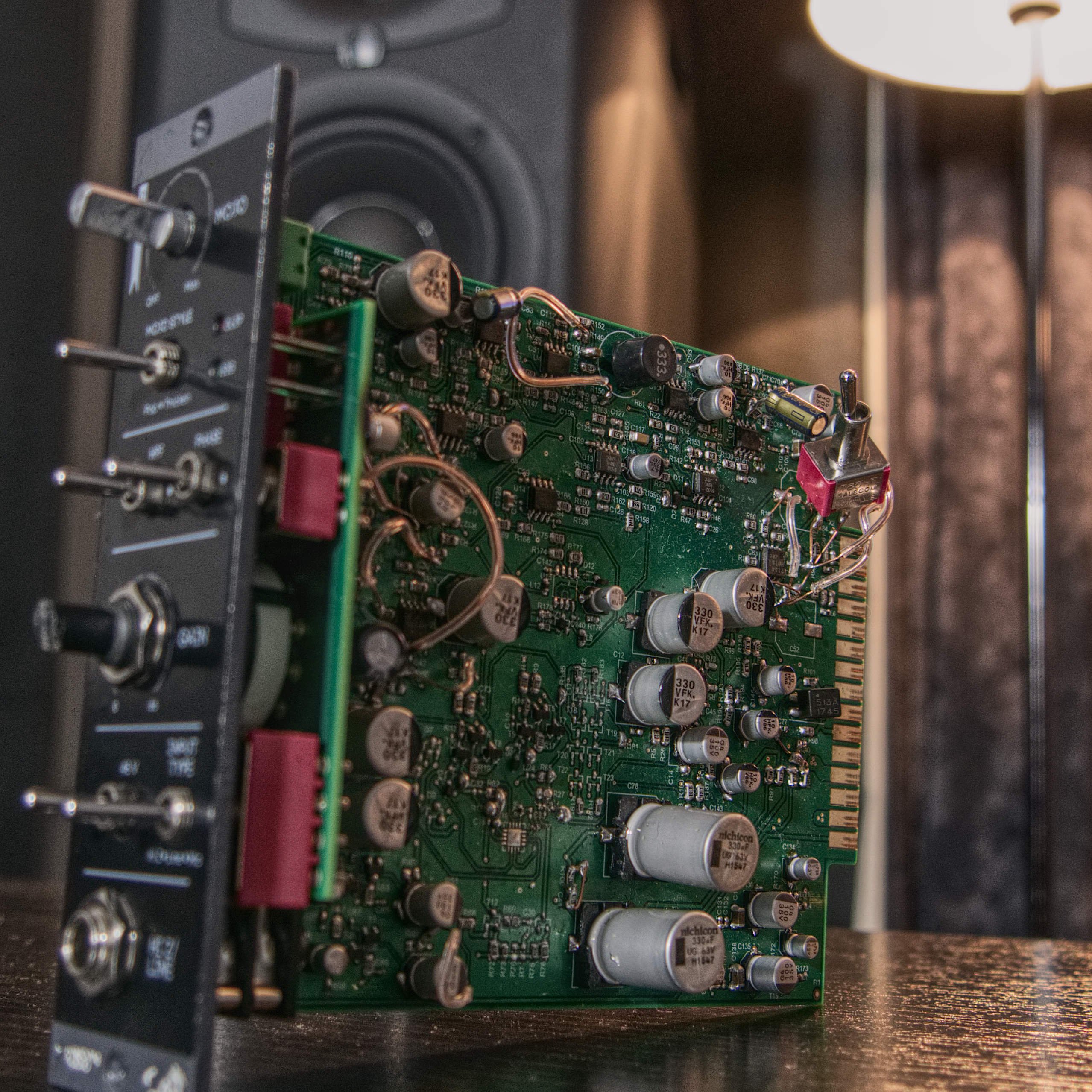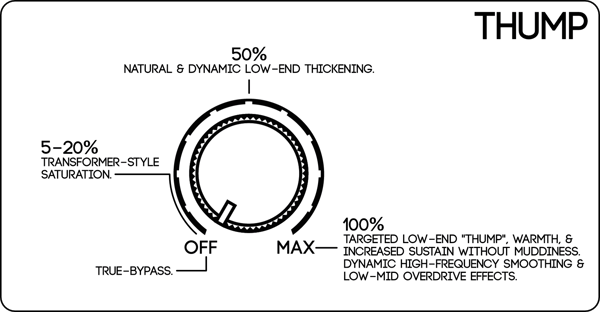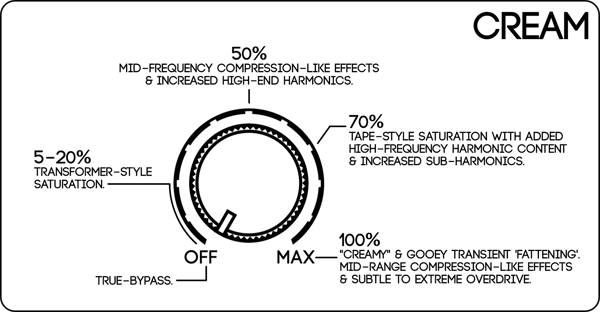Camden 500 was designed to capture sources with the utmost detail and precision, free of distortion and free of ‘colour’ to reveal the true and unaltered nature of your microphone and source. But for those moments when that vintage colour is required, Camden 500 has a trick up its sleeve - Mojo.
One turn of the Mojo dial, and Camden 500 transforms into a thick, gooey, and vintage sounding mic preamp that stands shoulder to shoulder with some of the most sought-after transformer-based preamps on the market.
But why did we develop Mojo? How did we make it work? What does it sound like? - let’s find out!
Why Mojo?
If you look at the current preamp market, you’ll see that what musicians/engineers look for in a preamp hasn’t really changed much since the 70’s. Even some ‘new’ preamps are only slight evolutions of circuits developed over 40 years ago - some products are direct clones!
The reason why these preamps are as popular now as they were back then is because of their tonal character. The polar opposite of Camden 500, these preamps apply huge tonal colouration onto audio signals - they add loads of distortion, add their own EQ influence transients, and add noise. The result however is that sound - that vintage, thick, gooey sound that we all of us musicians and engineers love on our recordings.
We wanted that sound on Camden 500. We wanted it to be a true Jekyll and Hyde preamp: clean and pristine one minute; vintage, fat, and saturated the next - but we didn’t want to compromise on either of those sounds to achieve the other. We wanted our cake, and we wanted to eat it.

We had a dilemma. In order to achieve the sound of a vintage preamp, we needed to use a transformer. But in order to achieve our goals in transparency, we had to avoid the colouration and saturation effects that a transformer adds onto an audio signal. We also wanted to take this saturation a step further and add precise control of exactly how much of that ‘vintage’ colour is added onto the signal - unlike transformers that are integral to the preamp to operate and can’t be removed from the signal path.
So we needed a variable saturation control that could be dialed to taste to achieve our desired vintage saturation, but most crucially it had to be bypassable to reveal Camden 500’s true and transparent nature - we needed to design something ourselves, we needed Mojo.

Here's one of our first prototypes. All of those components were hand soldered and all of those wire mods and switches were added when we were fine-tuning the Mojo circuit - perfection takes time!
What is Mojo?
Mojo started off as a research project. We wanted to measure the exact effects that transformers, valves, and vintage equipment had on audio signals passing through them, and by using our APx555 audio analyser we were able to decode the DNA of a ‘vintage sound’. A lot of the results were as we expected, but some of them were a bit of a surprise!
Now that we understood exactly how these revered preamps are influencing an audio signal - good or bad - we set to work at emulating the subtle and more aggressive "saturation" characters that transformers and other vintage equipment impart on audio signals in the least chaotic and damaging way so that the core of your audio signal - and the immediacy and transparency of the Camden topology - remains intact.
The result of this research is our Mojo control - a brand-new type of saturation circuit that is 100% analogue that consists of an array of filters and discrete second and third order harmonic generators that allow precise emulation of the saturation and frequency reinforcement behaviours of transformer-based designs and beyond. Mojo is the result of years of development and 6 unique iterations before we were completely happy with the results. The beauty with Mojo is that it is a variable effect that can be dialled-in to emulate the best aspects of a vintage preamp design (THD, EQ) without the downsides (Noise, Phase shift). Mojo can also be dialled in to 11 - far beyond the point where a traditional design would give up.
Compared to a transformer, Mojo can be changed at the flick of a switch to transform its effects into a completely different flavour of vintage saturation, whereas a transformer does what it does - it can’t be removed, and can’t be changed on the fly. Using this to our advantage, we installed Mojo with two Mojo styles that exhibit radically different saturation effects for a wider variety of sonic results. These styles are called Thump and Cream.
Thump is the direct result of our research into the effects that transformers have on audio.
It completely embodies all of the great characteristics of a transformer; increased THD, low-end thickening, and high-end smoothing, without the downsides mentioned in the previous section. Thump is a style that works best on - but is not limited to - low-frequency based instruments. Thump excites low-end content by boosting harmonics in the range of ~160Hz to 20Hz and below without increasing the fundamental frequencies - resulting in fuller low-end on all reproduction mediums.

As Thump is not EQ-based, the additional harmonic content generated by Thump is shaped by the source material and its existing low-end frequency content. This results in a natural addition of extra “Thump” that moves with the audio signal, increases when the audio level increases, and decreases organically when the audio level is decreased. If you were to emulate Thump’s effects using EQ, the result would be wooly and muddy as all the sonic energy is boosted - even unwanted audio in-between the hits.
- On instruments such as a drum machine, Thump adds harmonics onto the pure tones of the synthesis to engorge the signal with low-end harmonics and vintage drive that moves and swells with the audio signal to increase low-end saturation and sustain for a generally more lively, organic and ‘analogue’ sound.
- On VSTs, Thump is an amazing tool to add analogue warmth and vibe onto a completely ‘in-the-box’ sound. On programmed drums especially, Thump adds fullness but also dynamically smoothes the high-end response to make the drums seem to hit harder and have more body.
- On bass guitar, Thump is the go-to effect for delivering that smooth and harmonically rich low-end that a bass needs in order to sit at the bottom of a dense track. Thump also adds a dynamic high-end gooeyness that really helps keep the high-end attack of a bass Di under control - especially when tracking using a pick.
What is Cream?
Cream is something very different.
Cream more closely resembles valve and tape-style saturation and introduces a vintage smoothness that enables audio stems to sit deep within a complex mix in a way that cannot be replicated with EQ. The Cream setting drastically increases THD by up to 50% in some cases whilst smoothing out the low-mids and bringing forward the presence bands in a controlled and dynamic way. As with Thump, Cream is not EQ based and is purely achieved by blending two saturation stages with the dry signal and additional harmonics.

Cream varies entirely on the harmonic signature of the incoming source and It will increase high-end forwardness and create unique harmonic-based tonal shaping effects on mid-range instruments, but it will also add low-end on full range sources as well as unique “compression-style” effects on transients to make them sound bigger.
- On Synths, Cream is an extremely powerful tonal shaper that can transform a harmonically pure synth sound into a chewy and rich lead patch with enough bite to cut through a dense mix. Patches that already are harmonically rich can often benefit from Cream due to its aggressive mid range harmonic shaping and high-end forwardness helping the sound cut through.
- On Drums, Cream is an extremely powerful tool to tame transients and bring out the sustain and tonality of the drum itself in a way that doesn’t resemble compression. On overheads especially, Cream specifically targets the boxy frequencies of the drum kit whilst seeming to increase the overall size and power of the kit and room it was recorded in.
- Guitars are probably one of the biggest benefactors of Cream. A close-mic’d guitar cab can often suffer from boxiness and dullness as the mic is positioned further away from the cone. Cream perfectly brings back the cut, and forwardness from a mic’d cab without sounding artificial like an EQ and reacting dynamically to the guitar performance. On a guitar mic, Cream is a one-stop-shop tonal shaper that processes guitars perfectly to sit with the bass guitars and drums whilst still remaining audible.
The End Result
The result of years of painstaking research, tuning, tweaking, listening, and tuning again has culminated in Mojo - and it has blown away even our wildest expectations. It’s a very bold and treacherous path to go against the norms and set out to create as something so radically new that emulates a sound that’s so familiar to many but the more we hear it, and the more our customers are using it in their sessions, the prouder we are that Mojo can stand shoulder-to-shoulder - and sometimes exceed - the sound of legendary vintage preamps and other vintage gear.
But whilst Mojo was designed to accompany Camden 500’s clean front-end as it’s vintage and “Mr Hyde” character, Mojo and Camden 500’s clean front-end combine to create possibly the most versatile and powerful preamp/signal processor on the market today.
Mojo encapsulates our message perfectly - A Modern Approach To Vintage Sound.
Want to find out more about Camden 500?
Check out our Camden 500 By The Numbers Video where Elliott takes a deep-dive into the technical specifications of Camden 500 by comparing its performance specifications against some key competition.
Receive the latest product updates directly from the team.


Cranborne Audio, Harvest House, Cranborne Rd, Potters Bar, EN6 3JF
Privacy Policy | Warranty Policy